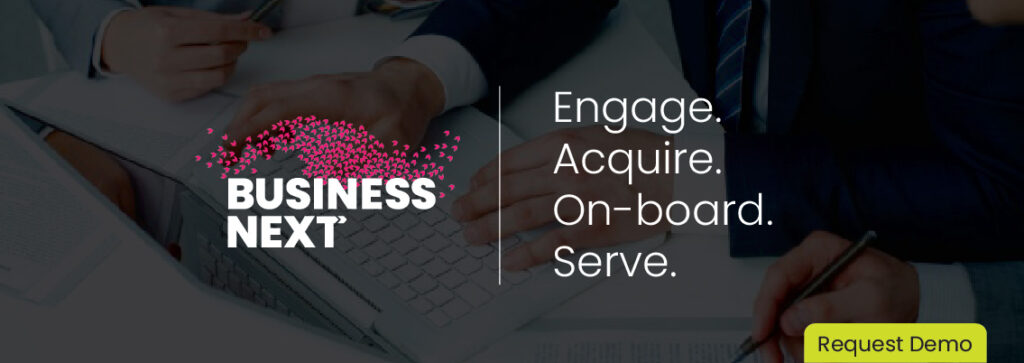Blog Details
Revolutionizing Customer Relationships: The Power of CRM Solutions for Lending Businesses in 2024
The Importance of CRM in Lending Businesses
CRM (Customer Relationship Management) is a crucial tool for digital lending as it helps in managing and nurturing customer relationships. Leading banks have embraced the digital lending revolution, achieving a remarkable “time to yes” of five minutes and a time to cash of less than 24 hours.
Implementing CRM solutions for lending like BUSINESSNEXT’s Digital lending platform allows lenders to have a centralized customer information database, including contact details, loan history, and communication logs. This enables lenders to have a comprehensive view of each customer, leading to better decision-making and personalized interactions. CRM also streamlines the loan application process by automating tasks such as data collection, document verification, and application tracking. This reduces manual errors and ensures a smoother and faster digital lending process.
Furthermore, CRM solutions for lending provide lenders with valuable insights through analytics and reporting. They can track customer behaviors, preferences, and patterns, allowing them to tailor their marketing and digital lending strategies accordingly. In summary, CRM is of utmost importance in digital lending as it enhances customer relationships, improves operational efficiency, and drives business growth.

Key Features of CRM Solutions for Lending
CRM solutions for lending offers a range of key features that help in managing customer relationships effectively.
- Centralized Customer Data:
- Capture and store customer information in a centralized database.
- Includes contact details, loan history, communication logs, and more.
- Provides a holistic view of each customer for personalized services and targeted marketing campaigns.
- Automation:
- Automate tasks such as data collection, document verification, and application tracking.
- Reduces manual effort and ensures a faster, more accurate digital lending process.
- Analytics and Reporting:
- Generate reports on customer behaviors, loan performance, and marketing campaigns.
- Make data-driven decisions to improve overall business performance.
- Integration with Other Tools:
- Seamlessly integrate with email marketing platforms, document management systems, and loan origination systems.
- Enhance efficiency and provide a seamless customer experience.
Best Practices for Implementing CRM Solutions for Lending Businesses
Implementing CRM solutions for lending businesses requires careful planning and execution. Here are some best practices to consider:
- Choose the right CRM solution: Evaluate different CRM solutions based on your business requirements and select the one that best fits your needs. Consider factors such as scalability, ease of use, integration capabilities, and pricing.
- Ensure data quality: Clean and accurate data is essential for effective CRM implementation. Regularly clean and update your data to ensure its quality. Implement data validation processes and train your staff on data entry best practices.
- Provide training and support: Proper training and support are crucial for successful CRM implementation. Train your staff on how to use the CRM system effectively and provide ongoing support to address any issues or questions that arise.
- Foster user adoption: Encourage your staff to fully adopt the CRM system by highlighting its benefits and providing incentives. Make it easy for them to access and use the system, and regularly communicate its value to the organization.
- Monitor and evaluate: Continuously monitor and evaluate the performance of your CRM implementation. Track key metrics such as customer satisfaction, productivity, and ROI to assess the effectiveness of your CRM solution.
- Define clear objectives: Before implementing CRM, clearly define your objectives and goals. Determine what you want to achieve with CRM and how it aligns with your business strategy.
By following these best practices, you can ensure a smooth and successful implementation of CRM in your lending business.
Measuring Success and ROI of CRM Implementation
Measuring the success and return on investment (ROI) of CRM implementation is essential to evaluate its effectiveness and justify the investment. Here are some key metrics to consider:
- Customer satisfaction: Measure customer satisfaction levels through surveys, feedback forms, and customer reviews. A higher customer satisfaction score indicates the positive impact of CRM on customer relationships.
- Lead conversion rate: Track the percentage of leads that convert into actual customers. A higher conversion rate suggests that CRM is effectively nurturing leads and driving sales. According to Gartner, organizations experience a 14% increase in sales productivity on average upon implementing CRM solutions for lending.
- Customer retention rate: Monitor the rate at which customers continue to do business with your company. A higher customer retention rate indicates that CRM is helping in building long-term relationships and customer loyalty.
- Productivity improvements: Measure the time and effort saved by automating manual tasks through CRM. Calculate the increase in productivity and efficiency achieved by using the CRM system.
- Return on investment (ROI): Calculate the financial return on investment by comparing the costs of implementing and maintaining the CRM system with the monetary benefits gained. Consider factors such as increased revenue, cost savings, and improved customer acquisition and retention.
Regularly track and analyze these metrics to assess the success of your CRM solutions for lending and make any necessary adjustments to optimize its impact.
Future Trends in CRM Solutions for Lending Businesses
The field of CRM solutions for lending businesses is constantly evolving, and several trends are shaping its future. Here are some key trends to watch out for:
- AI-powered CRM: Artificial Intelligence (AI) is playing an increasingly important role in CRM. AI-powered CRM solutions for lending like BUSINESSNEXT’s Digital lending platform can analyze large amounts of customer data, predict customer behavior, and provide personalized recommendations. This helps in delivering more targeted and effective marketing campaigns.
- Mobile CRM: With the rise of smartphones and mobile usage, mobile CRM has become crucial. Mobile CRM allows lenders to access customer data and perform tasks on the go, improving flexibility and responsiveness.
- Integration with other technologies: CRM systems are increasingly integrating with other technologies such as chatbots, voice assistants, and social media platforms. This integration enables lenders to provide seamless customer experiences across different channels.
- Enhanced security and data privacy: As data security and privacy concerns grow, CRM solutions are focusing more on enhancing security measures. Strong encryption, multi-factor authentication, and compliance with data protection regulations are becoming standard features in CRM systems.
- Predictive analytics: Predictive analytics is gaining prominence in CRM. By analyzing historical data and patterns, CRM systems can predict future customer behavior and enable lenders to take proactive actions.
- Enhanced customer experience: Customer experience is becoming a top priority for lending businesses. CRM solutions for lending like BUSINESSNEXT’s Digital lending platform are incorporating features such as personalized communications, self-service portals, and 24/7 customer support to enhance the overall customer experience.
By staying updated with these future trends, digital lending businesses can leverage CRM solutions for lending to stay competitive and meet the evolving needs of their customers.
In Conclusion
Implementing CRM solutions for lending businesses is no longer an option but a necessity in today’s competitive landscape. By embracing CRM solutions for lending like BUSINESSNEXT’s Digital lending platform, lenders can transform customer relationships, streamline operations, and drive business growth. Whether it’s capturing customer data, automating processes, or leveraging predictive analytics, CRM solutions for lending like BUSINESSNEXT’s Digital lending platform offers a multitude of benefits that can revolutionize the way digital lending operate. By adhering to best practices, measuring success, and staying abreast of future trends, lenders can harness the full potential of CRM solutions for lending to stay ahead of the curve and deliver exceptional value to their customers.


